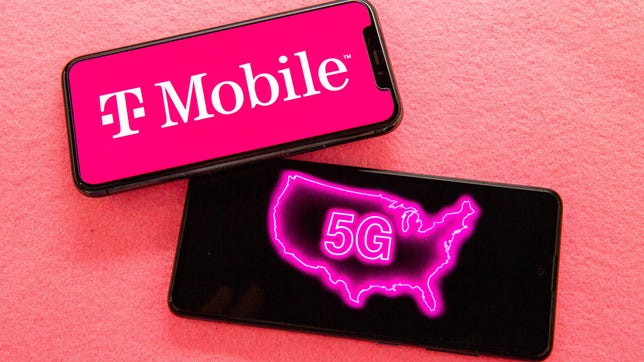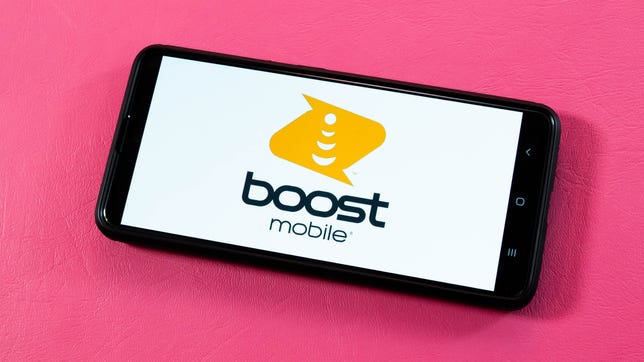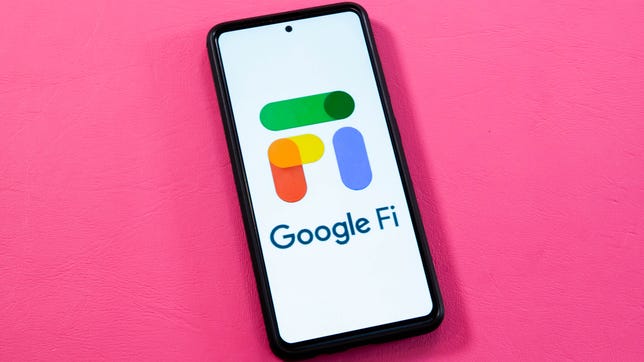
Picking or changing a phone plan isn’t easy. There are overwhelming number of options from the three main players, AT&T, T-Mobile and Verizon; as well as an exponentially larger assortment from prepaid and smaller mobile virtual network operator options like Mint Mobile, Visible, Google Fi and more. Sorting through it all is a hassle, which could very well be why you’re paying more for service you don’t need — or are not maximizing what you are paying to get the best value for your money.
Let’s try and fix that. We’ve been covering the latest in wireless plans across a host of providers and plans — from breaking down how to switch carriers, to the top unlimited and prepaid plans to knowing which network the smaller carriers use. Here is our guide for sorting through the madness and some of our picks for what we think are the best unlimited and prepaid plans available right now.

Sarah Tew/CNET
What’s the difference between “prepaid” and “postpaid” plans?
When choosing a phone plan there are generally two main options: a postpaid carrier like AT&T, Verizon and T-Mobile (plus cable options like Spectrum Mobile and Xfinity Mobile) and prepaid providers such as Mint Mobile, Metro by T-Mobile, Google Fi and Cricket.
The difference boils down to this: With postpaid you are paying for your plan after you’ve used your service, while prepaid lets you buy that allotment in advance.
Prepaid providers are generally cheaper than postpaid options, though they also often (but not always) are more limited when it comes to additional streaming perks, hotspot data or device discounts. To get a several hundred dollar trade-in credit toward a new iPhone, Pixel or Galaxy, you often will need to commit to a postpaid plan from one of the big three carriers and be willing to stay with that provider for 24 to 36 months.
All three of the major wireless carriers also offer a variety of discounts on the plan pricing depending on age, employment, military or veteran status or if you or someone on your family plan are a nurse, teacher or first responder. You can find those details here: AT&T, T-Mobile, Verizon.
Look at a zoomed-out map of the US on AT&T, T-Mobile or Verizon’s respective websites and you’ll likely see it pretty well colored in by their respective color. Zooming in is where things get a bit more complicated, which is why we can’t offer blanket recommendations for one carrier over another. T-Mobile’s service in New York may be excellent, but if you’re in a rural area in Colorado, Verizon could be more reliable.
All three, however, offer 5G and ever-increasing coverage and data speeds as they all ramp up deployments of the latest wireless flavor. It’s quite possible that a decade ago you left a network complaining about its weak service, but now it’s beefed itself up because of that race to acquire customers.
This is also why we recommend talking to friends, family or colleagues that have a different provider where you live, as locally your mileage may vary. You could also go to a carrier’s store and see if it offers any free ways to try out the service before switching over, such as T-Mobile’s Network Pass. Verizon now offers a similar 30-day “Test Drive” program, while the Cricket prepaid service has rolled out its own trial program that lets you sample parent AT&T’s network.
As for the smaller carriers, they often use the networks of the larger providers. This includes the prepaid options owned by the big carriers (AT&T owns Cricket, Verizon owns Tracfone, T-Mobile owns Metro) as well as smaller options like Mint Mobile (which runs on T-Mobile), Google Fi (which runs on T-Mobile and US Cellular) and Boost Mobile (which runs on AT&T, T-Mobile and parent company Dish’s 5G networks). We explain this all in more detail here.
If you’re on T-Mobile, all of your plans are unlimited, and Verizon no longer lets new users sign up for a shared data plan. Only AT&T still offers some tiered data plans and… it’s not great.
It has a 4GB-per-line plan that runs $50 a month for one line ($160 for four lines). Each line here gets 4GB of data, but if you go over that threshold in a month you’re paying $10 for every 2GB. AT&T’s plan also does not include access to its 5G networks.
Although everyone’s wireless needs are different, for most we think unlimited plans make the most sense, especially when it comes to choosing a new plan.
AT&T’s basic unlimited plan, called Unlimited Starter, is $65 a month for one line or $140 for four lines.
If you have one or two lines and don’t use a lot of data, you may be fine with one of these plans, though if you have just one line we’d recommend switching over to AT&T’s $50-per-month Value Plus option or T-Mobile’s Base Essentials. Two lines of that T-Mobile plan runs $80 a month, which is $10 cheaper than two lines of AT&T’s 4GB plan and comes without the worry of navigating how much data you use.
Sarah Tew/CNET
T-Mobile has a cheaper unlimited plan for those who don’t need three or more lines. Called Base Essentials, this plan has unlimited talk, text and data including 5G. While the data is unlimited, only the first 20GB each month are at high speed — if you go over that threshold, your speeds will slow to 1.5Mbps for the remainder of your billing period.
While perks like free Netflix or the bundling of taxes and fees into the sticker price are not included, you do get unlimited hotspot at “3G speeds,” a free year of Paramount Plus, and unlimited talk, text and 2G data in Mexico and Canada.
Priced at $5 less per month for a single line than AT&T’s Value Plus plan, this could be a solid option for those looking for a single line without frills. The carrier also allows for multiple lines via this plan, with two lines running $80 a month (if you need three or more you may want to look at one of T-Mobile’s other plans, which could be cheaper thanks to various promotions the carrier regularly runs).
T-Mobile keeps this plan surprisingly under wraps, but you can find it by heading to the “Plans” section of its website and clicking “lowest priced plan.”
Sarah Tew/CNET
Those looking to save the most on unlimited service from the major carriers may be best with T-Mobile’s Essentials. Unlimited talk, text and data are included for all of the carrier’s base unlimited plans. In this price-focused comparison, T-Mobile’s option comes in at $60 for a single line, $5 a month cheaper than AT&T’s Unlimited Starter and $10 less than Verizon’s 5G Start.
In addition to being $5 less than AT&T’s option, T-Mobile’s Essentials includes unlimited mobile hotspot (albeit at slower “3G speeds”), giving you a little more flexibility. All three carriers offer 5G access with their base plans. We should note that Verizon’s 5G Start doesn’t support its fastest forms of 5G.
You can always reevaluate your options as the three major carriers roll out the latest updates to their respective 5G networks over the next couple of years.
The savings of T-Mobile’s plan also become more pronounced the more lines you add. Two lines of Essentials is $90 a month, while a similar offering from AT&T or Verizon runs $120 a month. Three lines will also run $90 at T-Mobile thanks to a promotion, compared to $135 monthly at AT&T or Verizon. The four-line option is $100 at T-Mobile, compared to $140 at the other carriers.
These prices do come with a couple of caveats: Unlike T-Mobile’s Magenta or Magenta Max plans, taxes and fees are not included in any of these prices, making the final total a little higher. All the deals also require that you set up AutoPay and paperless billing.
Sarah Tew/CNET
If you’re looking for freebies with your wireless service, Verizon has one of the most aggressive bundles out there with its Play More plan ($80 a month for one line; $45 a month if you have four lines, you aren’t bringing your own phone and you’re switching to the carrier).
Verizon’s Play More plan includes unlimited talk, text and data and 25GB of higher-speed 5G and 4G LTE hotspot data. Among the perks are a free subscription to the Disney bundle (Disney Plus, ESPN Plus and Hulu) and either Apple Arcade or Google Play Pass.
All told, the perks quickly add up if you use any of these services. The Disney bundle normally runs $14 a month, and Apple Arcade and Google Play Pass each cost $5.
That’s potentially $19 a month in services. Verizon offers these benefits as part of its Play More and Get More plans, but for most people, the Play More choice is the best fit. Get More runs an extra $10 a month ($90 a month for a single line, $220 a month for four lines) and adds an extra 25GB of high-speed hotspot data, 50% off a connected device (like a monthly plan for tablet or smartwatch) and 600GB of Verizon’s Cloud Storage. Get More also includes a subscription to Apple Music, normally $10 a month.
Something to note: These perks are often limited to one per account, so only one line on a family plan would qualify to open a Disney Plus account and get it covered by the carrier.
Verizon also lets you mix and match plans when you have multiple lines.
If you have four people on your family plan, only one needs to have Play More to get the perks for the whole family. The rest can be on the cheaper 5G Start, which would make four lines $140 a month — as opposed to $180 a month if all four lines have Play More.
You can also combine these plans with Verizon’s other discounts for teachers, nurses, military and first responders to save a bit more.
Lastly, Verizon has a “One Unlimited for iPhone” plan geared toward Apple fans that includes the Apple One bundle (Apple Music, Apple TV Plus, Apple Arcade and iCloud storage). The pricing on that plan ($90 per month for one line, $200 a month for four lines) is higher than Play More, however, and the One plan lacks the ability to put other lines onto cheaper plans. Combining those two factors makes this option a worse deal than the Play More plan.
Sarah Tew/CNET
Boost Mobile has added an unlimited plan that offers unlimited talk, text and data to new users for $25 per month with taxes and fees included. Unlike Mint Mobile’s 12-month plan, our previous pick in this slot, Boost’s plan isn’t tied to 12-month increments. You do, however, need to be a new Boost customer to get this offer.
The plan includes 5G access and 30GB per month of high-speed data (if you blow through that, your data will slow until your next billing month starts). Hotspot is included as well, with that data pulling from your high-speed allotment. One thing worth noting: You need to set up automatic payments to get the $25-per-month rate.
Sarah Tew/CNET
Google’s cellphone service got a pricing revamp that makes it a much more appealing alternative to major providers. For a family of four, you can now get its Simply Unlimited plan for $80 per month ($20 per month, per line) which includes not only unlimited talk, text and data but also 5GB of mobile hotspot access. There also is free roaming in Canada and Mexico, though taxes and fees are not included in the sticker price.
Google Fi runs on T-Mobile’s and US Cellular’s networks and its service includes 5G access, though we should note that iPhones running on Google Fi can’t use 5G.
Sarah Tew/CNET
When it comes to data under 10GB, Mint once again has the best value if T-Mobile’s network is solid in your area. Whereas Metro and Cricket charge $40 per month for one line and Boost has a $35 plan for 10GB of data, Mint beats them all on price.
Getting 10GB of 4G LTE/5G monthly data is $20 per month at Mint when purchased in 12-month increments for new users. After that, you can buy three more months at $35 per month ($105 total), six months at $25 per month ($150 total) or another year at $20 per month ($240 total).
Sarah Tew/CNET
If you’re looking for service for a backup phone that’s rarely used, TextNow has a free plan. Running on T-Mobile’s network, the service offers free unlimited talk and unlimited texting, though ads are placed in its app which you use to call and text people. There isn’t any data included with this option and removing the ads without adding data would run you $10 a month. If you want to watch YouTube, FaceTime, or surf the web make sure to connect to Wi-Fi.
Text messages are also done through the company’s TextNow app, not through iMessage or WhatsApp which makes sense as those services require data.
Getting 1GB of high-speed mobile data starts at $9 a month, with the company throttling you down to “2G speeds” if you use that up before your billing cycle resets. If you are largely on Wi-Fi, this could be a good option. 2GB runs $16 a month, with the company offering up to 5GB of high-speed data for $28 a month.







